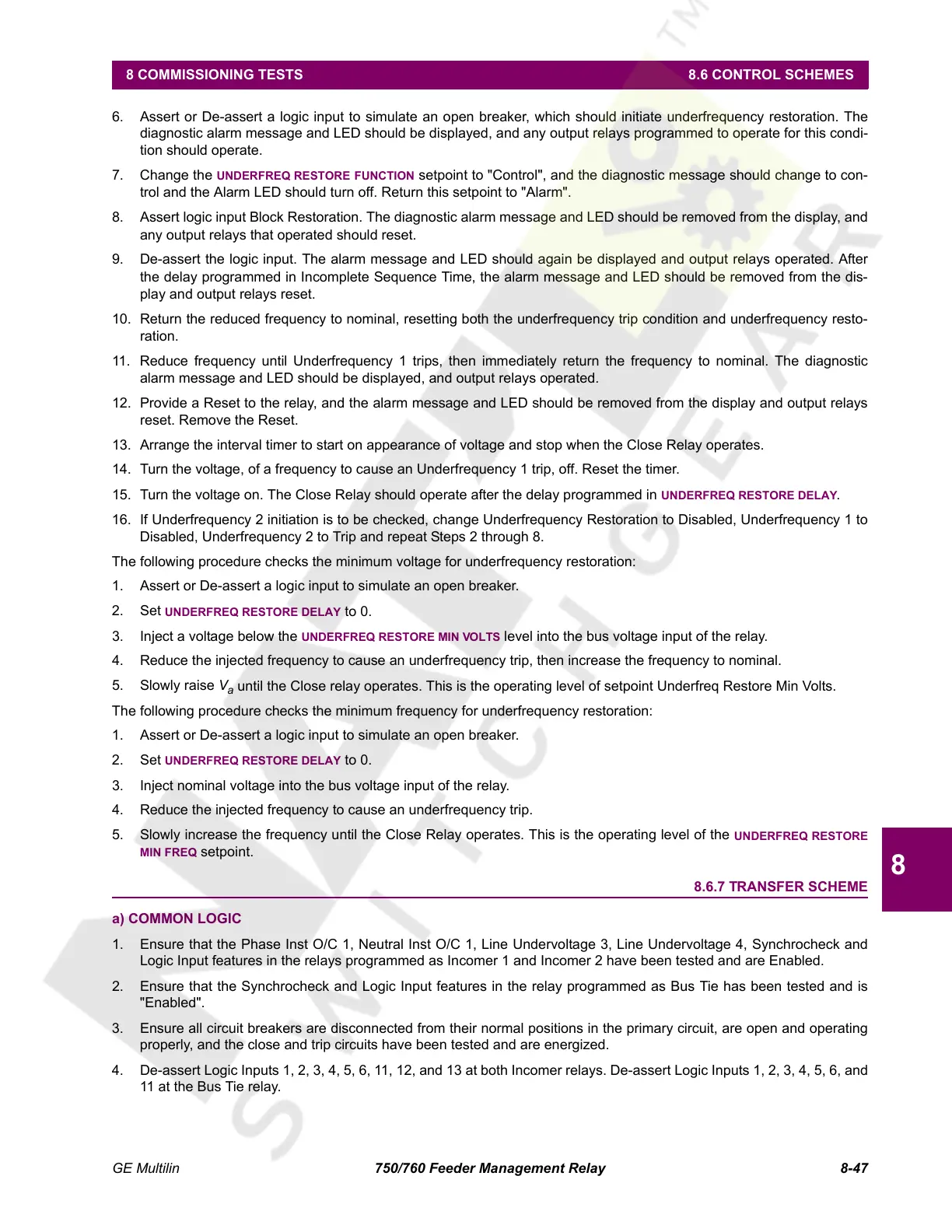GE Multilin 750/760 Feeder Management Relay 8-47
8 COMMISSIONING TESTS 8.6 CONTROL SCHEMES
8
6. Assert or De-assert a logic input to simulate an open breaker, which should initiate underfrequency restoration. The
diagnostic alarm message and LED should be displayed, and any output relays programmed to operate for this condi-
tion should operate.
7. Change the UNDERFREQ RESTORE FUNCTION setpoint to "Control", and the diagnostic message should change to con-
trol and the Alarm LED should turn off. Return this setpoint to "Alarm".
8. Assert logic input Block Restoration. The diagnostic alarm message and LED should be removed from the display, and
any output relays that operated should reset.
9. De-assert the logic input. The alarm message and LED should again be displayed and output relays operated. After
the delay programmed in Incomplete Sequence Time, the alarm message and LED should be removed from the dis-
play and output relays reset.
10. Return the reduced frequency to nominal, resetting both the underfrequency trip condition and underfrequency resto-
ration.
11. Reduce frequency until Underfrequency 1 trips, then immediately return the frequency to nominal. The diagnostic
alarm message and LED should be displayed, and output relays operated.
12. Provide a Reset to the relay, and the alarm message and LED should be removed from the display and output relays
reset. Remove the Reset.
13. Arrange the interval timer to start on appearance of voltage and stop when the Close Relay operates.
14. Turn the voltage, of a frequency to cause an Underfrequency 1 trip, off. Reset the timer.
15. Turn the voltage on. The Close Relay should operate after the delay programmed in UNDERFREQ RESTORE DELAY.
16. If Underfrequency 2 initiation is to be checked, change Underfrequency Restoration to Disabled, Underfrequency 1 to
Disabled, Underfrequency 2 to Trip and repeat Steps 2 through 8.
The following procedure checks the minimum voltage for underfrequency restoration:
1. Assert or De-assert a logic input to simulate an open breaker.
2. Set
UNDERFREQ RESTORE DELAY to 0.
3. Inject a voltage below the UNDERFREQ RESTORE MIN VOLTS level into the bus voltage input of the relay.
4. Reduce the injected frequency to cause an underfrequency trip, then increase the frequency to nominal.
5. Slowly raise V
a
until the Close relay operates. This is the operating level of setpoint Underfreq Restore Min Volts.
The following procedure checks the minimum frequency for underfrequency restoration:
1. Assert or De-assert a logic input to simulate an open breaker.
2. Set
UNDERFREQ RESTORE DELAY to 0.
3. Inject nominal voltage into the bus voltage input of the relay.
4. Reduce the injected frequency to cause an underfrequency trip.
5. Slowly increase the frequency until the Close Relay operates. This is the operating level of the
UNDERFREQ RESTORE
MIN FREQ
setpoint.
8.6.7 TRANSFER SCHEME
a) COMMON LOGIC
1. Ensure that the Phase Inst O/C 1, Neutral Inst O/C 1, Line Undervoltage 3, Line Undervoltage 4, Synchrocheck and
Logic Input features in the relays programmed as Incomer 1 and Incomer 2 have been tested and are Enabled.
2. Ensure that the Synchrocheck and Logic Input features in the relay programmed as Bus Tie has been tested and is
"Enabled".
3. Ensure all circuit breakers are disconnected from their normal positions in the primary circuit, are open and operating
properly, and the close and trip circuits have been tested and are energized.
4. De-assert Logic Inputs 1, 2, 3, 4, 5, 6, 11, 12, and 13 at both Incomer relays. De-assert Logic Inputs 1, 2, 3, 4, 5, 6, and
11 at the Bus Tie relay.
Courtesy of NationalSwitchgear.com

